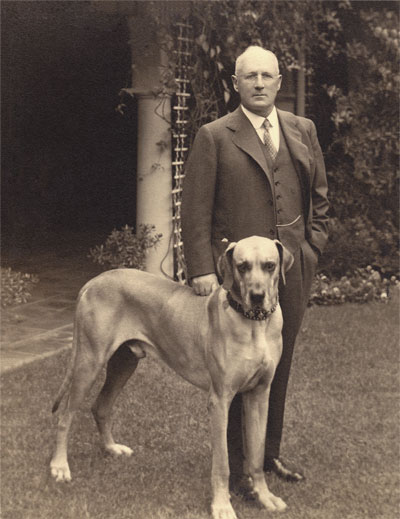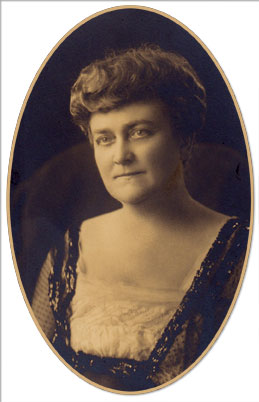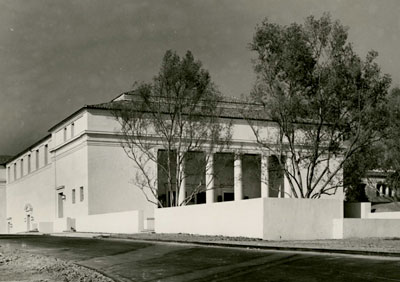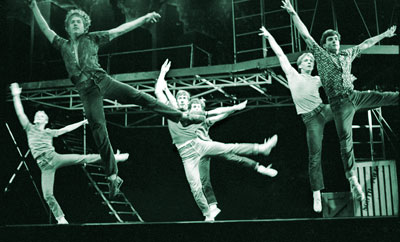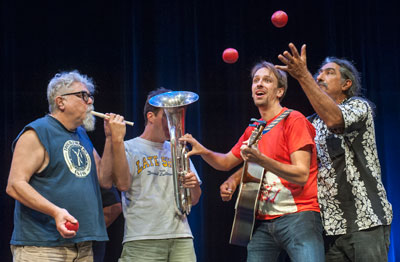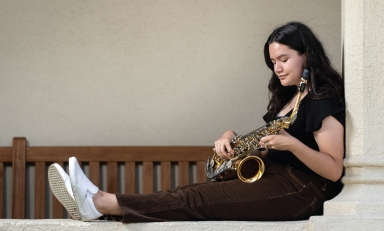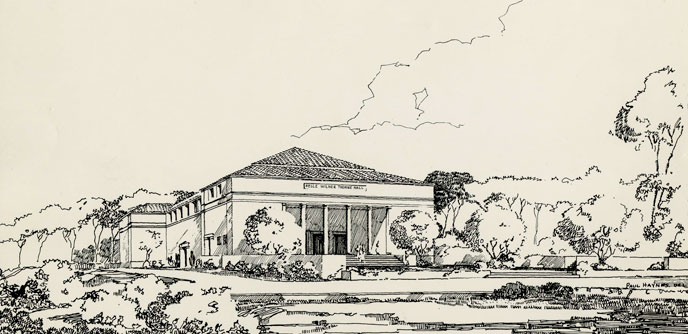
For 75 years, Thorne Hall has stood as the preeminent symbol of Occidental—the anchor of its educational and cultural pursuits. But it may have never been built without the vision, and checkbook, of Oxy's "Uncle Charlie"
By Paul Robert Walker '75
"Occidental College has entered its fiftieth year and, as is customary and fitting, numerous gifts and aids may be expected.
"Because of its good reputation, its ideals, its faculty, and its peculiarly favorable location, the college is unusually fitted to carry on, in addition to customary work, many forms of public relations and interlocking relations with other institutions with varying purposes.
"To place itself in position to accomplish the most and best work, to attract students who sometimes go elsewhere for more and complete facilities, and to reach its proper place in the minds of the public, educators and related interests, some additions are greatly needed."
Thorne Hall stands regal and serene above the Quad, a constant reminder to Occidental students and faculty of the classical foundation of their educational pursuits. Beyond the quietly elegant façade, however, is a vibrant performance space that has been home to a dizzying array of events, including—to mention a few—solemn academic convocations, soaring organ recitals, sublime concerts by Marian Anderson and Leontyne Price, the madcap shenanigans of Bob Hope's radio broadcast, the transformative oratory of the Rev. Martin Luther King Jr., dramatic performances by national touring companies and generations of Oxy students, and all 32 of emeritus professor of music Richard Grayson's legendary annual keyboard improvisation recitals.
Completed in 1938, Thorne was architect Myron Hunt's last major design for the Occidental campus. It hearkens back to the classical style of his earliest buildings, Fowler and Johnson halls, while also "paring away details to almost pure geometry," in the words of Robert Winter, Arthur G. Coons Professor of the History of Ideas Emeritus. Thorne is so fundamental to Occidental's image that it appears in the College's centennial seal and adorns business cards.As difficult as it is to imagine Oxy without Thorne Hall, there was a time when it was just an empty space on a barren knoll on the northern end of campus. The story of how it came to be is a tale of a friendship between two unusual men: Oxy's longest-serving president, the Rev. Remsen D. Bird, and one of its most influential trustees, Charles Hallett Thorne.
When Bird took office in 1921, he embarked on an ambitious program aimed at expanding and developing the College on all fronts: students, faculty, alumni, the community, and the buildings that would bring them together. The prosperous 1920s brought a steady succession of Hunt-designed buildings to campus, but the program ran into the financial buzz saw of the Great Depression, forcing Bird to scramble for donations just to pay the bills. An inveterate list maker, Bird regularly identified three construction projects of paramount importance: an auditorium that could hold all of Oxy's students and faculty, an administrative building, and more student dormitories.
It was at this juncture that Bird met Charles Thorne, the second of five sons of Montgomery Ward co-founder George Thorne. The Ward and Thorne families were connected not only by business partnership but also by marriage—Mrs. Ward and Mrs. Thorne were sisters. In 1893, Montgomery Ward and George Thorne retired from active leadership, leaving the booming mail-order firm in the capable hands of Thorne's sons, led by the eldest, William. Charles, who was 24 at the time, became second-in-command (less than two years after he married the former Belle Wilber in December 1891).
All of the Thorne boys "had to go through the jumps and learn the business from the ground up," Charles later said. That was literally true for him—his first job was sorting catalog pages in a basement under a sidewalk, lit by the dim glow of gas lamps. "It was dark and damp and gloomy," he recalled in an interview for a company history. "I used to get very sleepy and would go out in the shipping room and hustle boxes until my circulation woke me up again."
By the first decade of the 20th century, Charles Thorne was treasurer of Montgomery Ward and became involved in two projects that developed his interest in building and architecture. From 1906 to 1908, he spearheaded construction of a new mail-order house on the Chicago River. It was the largest commercial building in the world at that time, 500 feet long, 270 feet deep, and nine stories high, creating 2 million square feet of space—with railroad tracks that ran from one end to the other, so that two trains could load and unload simultaneously.
Around the same time, Thorne joined the commission led by pioneering urban architect Daniel Burnham to develop the Plan of Chicago, a visionary city-planning exercise published in 1909. Surviving documents indicate that Thorne brought hard-nosed business sense to the process while looking after his uncle Montgomery Ward's commitment to preserve the Chicago lakefront for future generations—an effort that can be appreciated today in Chicago's Grant Park.
In 1912, Thorne, who clearly had a gift for finance, took Montgomery Ward & Co. public on the New York Stock Exchange while maintaining family control. He was elected company president in 1914 but resigned two years later, handing the reins to his youngest brother, Robert. His explanation reveals a private character that may explain why Charles Thorne has remained relatively unknown to the Occidental community: "Before [becoming president], I enjoyed business—after that, I did not. It wasn't the business responsibility that bothered me. It was the necessity for public statements, and I am so constituted that I can't talk about my affairs to any one else, even though they are entitled to know."
Thorne remained chairman of the board, while stepping into public service as the first director of the newly organized Illinois Public Welfare Department, where he reported directly to the governor and had sweeping control over public charity, prisons, and probation—a groundbreaking experiment in Progressivism.
From public welfare, it was a short leap to educational philanthropy. In 1923, Thorne advised his aunt, Elizabeth Ward, in donating the then-stunning sum of $4 million to erect a 20-story building for the Northwestern University Medical School as a memorial to her late husband—followed by another $4 million in 1926. He also worked with his mother in donating a Thorne Hall for Northwestern in honor of his father, featuring a grand auditorium much like Oxy's Thorne Hall. (The original Thorne Hall was demolished in 1981 for university expansion, but a more modern Thorne Auditorium in the Northwestern School of Law is still in use.)
Thorne's focus shifted from Northwestern to Occidental after he and Belle moved to Pasadena in 1928. His connection with the College was cemented that December, when his niece, Eleanor Donnelley—daughter of publisher Reuben H. Donnelley and Charles' sister, Laura—married Oxy professor of Biblical literature Pardee Erdman. (Erdman Hall, built in memory of Pardee's first wife, Grace Carter Erdman, had opened in 1927.) Eleanor Erdman must have encouraged her "Uncle Charlie" to bring his talents for finance and philanthropy to help her new husband's college. He became a trustee in April 1931 and so quickly immersed himself that just seven months later, Bird wrote, "We have a real friend discovered and the saints be praised!"Although Bird doubtless meant "a real friend of the College," his journal entries make it clear that the older man (20 years Bird's senior) became a trusted personal friend and adviser. Their correspondence grew increasingly warm and familiar—Thorne addressed the president as "Dear Remsen," or "My dear Dr. Bird," while Bird, in time, referred to Thorne as "My dear Charles" or "Uncle Charlie"—and they traveled together to meet other Oxy friends and prospective donors. Bird baptized Thorne's grandchildren, and he served as godfather to Charles Hallett Thorne II, named after his grandfather.
Thorne served on both the executive and finance committees of the board, charged with advising Bird as he navigated the quicksand of building a college while the economy collapsed around them. Although fiscally and politically conservative, Thorne firmly believed in academic freedom and offered much-appreciated support to Bird in the face of unfounded accusations of harboring Communist-leaning faculty. He also cautioned the president that he might lose valuable professors due to religious restrictions placed on the faculty by funding from the Presbyterian Church.
Thorne's personal giving built slowly with relatively small donations to the biology department and scholarship fund. The faculty remained a special interest, however. And after his wife, Belle, passed away on Christmas Day, 1934, Thorne gave Oxy two life insurance policies, collectively valued at $100,000, with an additional $50,000 gift contingent "upon the raising of another $450,000 additional for general endowment for care of the faculty." In a note dated Oct. 28, 1935, he wrote: "Colleges are like individuals. If they spend their whole income sometime they will be caught in an unpleasant situation, whereas if they are thrifty and open a savings account they will after a few years find themselves able to live through the proverbial rainy day or carry out some dreams."
One year later, on Oct. 29, 1936—in honor of Oxy's 50th anniversary—Thorne committed the $150,000 cash needed to fulfill Bird's dream of an auditorium. The building would be named Belle Wilber Thorne Hall as a memorial for his late wife. "She had known and loved Occidental," daughter Leslie recalled, "and it was rapidly becoming a first-rate college worthy of her memory."
Thorne's "coming into the college out of the suffering and loneliness in the passing of his wife has been unquestionably a power for him and of great good to us," Bird noted at that time. "Elizabeth Thorne, his daughter-in-law, graciously says the college has done quite as much for him as he has done for it."
The gift came with a number of conditions, all designed to make the College a more mature and viable entity for generations of students to follow. In addition to raising an additional $100,000 for the faculty endowment to replace the value of Thorne's insurance policies, he also stipulated that two dormitories be completed, that the quadrangle of the interior campus "be rebuilt and replanted in accordance with general schematic plans and that an experienced landscape architect be engaged for the detailed landscape work," and that "the periphery of the campus be curbed, planted, and groomed." As he rightfully noted: "General grooming of the campus will, in conjunction with certain new buildings, please the eye, make friends, and attract new students."
The conditional nature of Thorne's gift caused some consternation among other donors, but Bird felt the conditions were reasonable and that they would help push the College in the right direction. "Mr. Thorne's character and remarkable ability to light fires and enrich flames gives one a lift at the moment," he wrote. "I think we are coming into a very great period for Occidental."
After the ceremonial groundbreaking on May 21, 1937, construction moved quickly, and Thorne covered cost overruns for a total of about $264,000. Fellow trustee Elizabeth Clapp McBride '19 and her husband, Euclid McBride, donated an Aeolian-Skinner organ with four manual keyboards, a pedal keyboard, and 66 stops, all connected to some 4,000 pipes. The cost of the organ: $21,973. "While not the largest organ in the West, it is, through tonal quality and equipment, one of the finest," Oxy claimed.
By commencement weekend in early June 1938, the hall was near enough to completion that an exhibit of paintings by Oxy professor Tom Craig was held in the foyer. The auditorium was first used on July 13, 1938—on the eve of the summer meeting of the Board of Trustees—with a concert given by a group from the Westminster Choir School. Comptroller Fred McLain told the trustees the following day that "the concert was a great success … and that the acoustic conditions seemed to be absolutely perfect."The hall was officially christened on Sept. 21, 1938, with the 51st annual convocation of the College. Oxy faculty, administrators, and students formed a procession "from all corners of the campus to file into the new auditorium," the College alumni magazine reported. Brave New World author Aldous Huxley, a personal friend of Bird's, delivered the convocation address on the subject "Words and Their Meanings."
(The English writer used the donation and opening of Thorne Hall as a small thread in his 1939 novel After Many a Summer Dies the Swan. While Huxley's portrayal of Tarzana College president Herbert Mulge—presumably modeled after Bird—is less than charitable, the donor—patterned after William Randolph Hearst—could not be further from the unpretentious, limelight-shunning Charles Thorne. Huxley, who had been offered a position as professor of English before the book's publication, was reportedly banned from campus soon after.)
From the outset, Thorne Hall was a boon not only to the College but also to members of the community, who attended Oxy-sponsored events and used the space to stage their own gatherings, an open-door policy that continues today.
"Belle Wilber Thorne Hall today is more than a structure of steel and concrete," Thorne Hall director and music professor Howard Swan reported in December 1940. "Thorne Hall is an institution, fostering activities that reach out and touch many interests and many persons. The donor of the building wished it to receive extensive use; certainly none of us realized that we were so soon to witness the development of an institution of strength, tradition, and power."
Three signature series were established early on. The Artist Series brought a long parade of performers to campus, from rising stars to seasoned veterans at the height of their popularity. The Lecture Series featured thought-provoking speakers from across the intellectual and political spectrum, while the Travel Series transported generations of armchair travelers beyond the wood-paneled walls. In the 1953-54 edition of Thorne's Foyer magazine, it was estimated that "well over a million persons have passed through the doors of Thorne Hall."While the three series were discontinued in the late 1980s, Thorne Hall today attracts a steady stream of world-caliber entertainers through the G. William Hume Fellowship in the Performing Arts. The fellowship was created in 2001 through a trust created by Hume, who earned his undergraduate and master's degrees from Oxy in 1950 and 1952, respectively, and served as director of Thorne Hall from 1958 until 1967.
Thorne has always been an educational facility as well. From 1947 to 1971, the auditorium served as a classroom for History of Civilization lectures and, until the construction of Keck Theater in 1989, was the primary teaching space for Occidental theater students. It remains a learning laboratory for technical theater students who produce events from children's choirs to national touring companies. Brian Fitzmorris—who as professor of theater practice stands in a line of Thorne program directors going back to Swan—points out that having the opportunity to work in both Thorne and Keck gives students an unusually broad experience. "They develop original productions in Keck over a period of weeks, and present touring productions in Thorne over a period of hours."
Professor of theater emeritus Omar Paxson '48 fondly recalls student-directed productions in the Little Theater below the main stage and the initiation ceremony for the Occidental Players—which required crawling through a small opening in the office of speech education department chairman Charles Lindsley, high above the lobby, and then walking across the auditorium in the space below the roof. "I always thought of Thorne as home," Paxson says. "It was home for the students, too."
Although the iconic façade remains immutable, a line of windows on the western wall was removed in the late 1960s, followed by a major interior renovation in 1989. To update the acoustical properties—exceptional by 1938 standards but not so great 50 years later—the walls were reapplied, an orchestra shell was built for the stage, and acoustic "clouds" were added to the ceiling. Seating was reconfigured to provide more legroom, improve sightlines, and create space for a floor-level production booth, reducing capacity from 960 to 792. The organ, long in disrepair, was taken out of service, but its myriad pipes remain embedded in a dark, dusty place.Even with these changes, the structure appears very much as it did when Charles Thorne officially opened its doors. In making the gift, he wrote, "My general purpose is to help make possible a campus which will be one of the most beautiful and effective in the college world, to the end that more people may be better educated and be in position to do their part in saving civilization from the devastation which now threatens."
While the latter phrase may seem a bit overheated today, the belief that a "beautiful and effective campus" might produce educated men and women who can make a difference in the world lies at the heart of the Oxy experience. Thorne understood that, though he was puzzled by the "lack of imagination" that chose the name Occidental. "It sounds like a Chinese laundry or cleaning establishment," he wrote Bird in 1939. "However, it probably cannot be changed."
Paul Robert Walker '75 recalls attending Thorne Hall concerts by Tom Waits (opening for Linda Ronstadt) and classical guitarist Christopher Parkening, and a production of Shaw's Saint Joan, directed by Omar Paxson.

